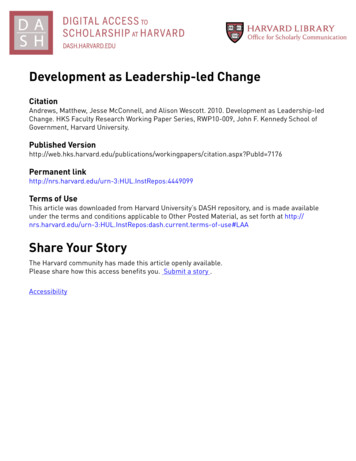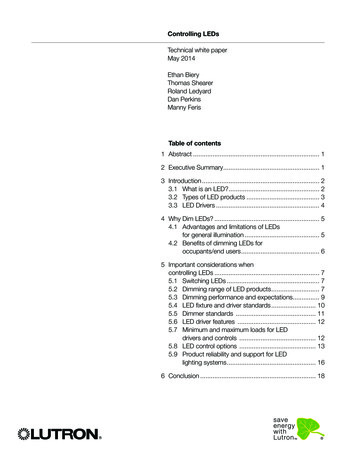
Transcription
Development as Leadership-led ChangeCitationAndrews, Matthew, Jesse McConnell, and Alison Wescott. 2010. Development as Leadership-ledChange. HKS Faculty Research Working Paper Series, RWP10-009, John F. Kennedy School ofGovernment, Harvard University.Published kingpapers/citation.aspx?PubId 7176Permanent 9099Terms of UseThis article was downloaded from Harvard University’s DASH repository, and is made availableunder the terms and conditions applicable to Other Posted Material, as set forth at rrent.terms-of-use#LAAShare Your StoryThe Harvard community has made this article openly available.Please share how this access benefits you. Submit a story .Accessibility
Development as Leadership-LedChange - A Report for the GlobalLeadership Initiative and theWorld Bank Institute (WBI)Faculty Research Working Paper SeriesMatt AndrewsHarvard Kennedy SchoolJesse McConnellReform Development ConsultingAlison WescottWorld Bank InstituteMarch 2010RWP10-009The views expressed in the HKS Faculty Research Working PaperSeries are those of the author(s) and do not necessarily reflect those ofthe John F. Kennedy School of Government or of Harvard University.Faculty Research Working Papers have not undergone formal review andapproval. Such papers are included in this series to elicit feedback andto encourage debate on important public policy challenges. Copyrightbelongs to the author(s). Papers may be downloaded for personal useonly.www.hks.harvard.edu
Development as Leadership-led Change1A Report for the Global Leadership Initiative2 and the World Bank Institute (WBI)Matt Andrews3, Jesse McConnell4 and Alison Wescott51The findings, interpretations, and conclusions expressed in this paper are entirely those of the authors.They do not necessarily representthe views of the International Bank for Reconstruction and Development/ World Bank, or the World Bank Institute (WBI) and its affiliated organizations, those of theExecutive Directors of the World Bank, the governments theyrepresent or the members of the Global Leadership Initiative Working Group.2This work was financially and logistically supported by the Global Leadership Initiative, a partnershipcomposed of then World Bank Institute, U.K. Department for International Development, CanadianInternational Development Agency, UNDP, and the French Ministry of Foreign Affairs3Assistant Professor of Public Policy, Harvard Kennedy School.4Reform Development Consulting, Durban, South Africa.5World Bank Institute.1Electronic copy available at: http://ssrn.com/abstract 1551375
ContentsIntroduction. 3Development as change . 4Context and the importance of change space. 5Process and the case for dynamic change space . 7Content, the possibilities of problems, and contingency of change space. 9Leadership and change: Theory and propositions . 10Who is the leader, and why? . 10What do leaders do, and how? . 13Context and leadership. 17Examining our propositions: A Method . 19Research approach and data sources. 19Ensuring the cases matched our expectations. 22Examining leadership-led change propositions: Results and discussion. 26Leadership’s ‘who’ and ‘why’ . 26The multiplicity of leadership . 27The functionality of leadership . 31Centrality of the ‘connecting function’ . 32Leadership’s ‘what’ and ‘how’ . 34What and how leadership impacts on Acceptance. 35What and how leadership impacts on Authority . 39What and how leadership impacts on Ability . 43Conclusions on leadership’s ‘what’ and ‘how’ . 45Leadership and context . 47Conclusions, and a case for more leadership work in development . 50Annex 1. Five stages in the change process: A simple model . 52Annex 2. ‘Who’ were identified as leaders (number of references in parantheses) . 54References. 562Electronic copy available at: http://ssrn.com/abstract 1551375
IntroductionDevelopment involves change. But many development initiatives produce unimpressivelevels of change in targeted countries, organizations and outcomes. This is the case insocial sector initiatives,i core public management reforms,ii and even macroeconomicadjustment operations.iii Change is often limited even when countries adopt proposedsolutions in their proposed forms, in apparently good faith and on time (or in reasonabletime).iv We wonder why, and believe research should ask how to close the gap betweenthe change intended in development (what is proposed) and the change we actually see inevidence. This research paper aims to (modestly) contribute to such research by exploringwhat it takes to get change done; and particularly what role leadership plays in effectingchange.The first section briefly discusses literature on change in large organizations and proposesa simple change space model for understanding change and its limits. The model positsthat organizational and social change emerges when there is acceptance, authority (andaccountability) and ability to allow and catalyze ongoing as well as episodic adjustments.This space is required to ensure contextual readiness for change and to foster progressionthrough different stages of the change process.Change space must fit the specific change content and, we argue, emerges moreorganically to ensure such fit when change content emerges through problem solving(instead of as solutions provided from the outside). The lack of change space in manydevelopment contexts often goes ignored, contributing to developmental failures: Projectsand interventions generally call for more and different space than is available, do nothingto enhance or shape the space (depending rather on what Nutt (1986) calls“implementation by edicts” of pre-determined solutions) and fail as a result. Often, asPritchett and Woolcock (2004) muse, these solutions become future problems.The second section asks what role leadership plays in the change process (particularly infacilitating the creation of change space) given that there is an almost universalagreement that agents play an important part. The answer must go beyond “being achampion” and “providing political will”—two common refrains used in development toreference leadership. In looking for an answer, we raise basic but key questions: Who isseen as the change leader? Why? What do leaders do to effect change? How? Tacklingthese questions with reference to literature, we posit some propositions about howleadership manifests and matters in the change process: Leadership is more about groups than individuals, given that there are likely to bemultiple people exercising leadership in any successful change event.‘Leaders’ are identified more because of their functional contribution to change thantheir personal traits or authority (and the ‘connecting’ function stands out).Leadership contributes to change when it builds change space—where leaders fosteracceptance for change, grant authority to change (with accountability), and introduceor free the abilities necessary to achieve change. Change space is especially enhancedwhere leadership facilitates open access societies and learning organizations in whichmembers are empowered—in groups—to pursue change through problem solving.Leadership manifests in different ways in different contexts, depending on contextualreadiness and factors that shape change and leadership opportunities; but the key3
characteristics of plurality, functionality, problem orientation and change spacecreation are likely to be common to all successful leadership-led change events.Section three introduces an empirical study we conducted to investigate thesepropositions in the development context. It begins by pointing out that some developmentinterventions do already propose leadership-led change, introducing brief examplescaptured by the multi-donor Global Leadership Initiative (GLI).v We examined whatleadership looked like in the change processes of fourteen such interventions (in eightdifferent developing countries) where we conducted over140 in-depth structuredinterviews as the primary source of data. We focus on fragile countries, coming out ofconflict, facing tense government transitions, and so forth, because we see these asextreme cases where expressions of leadership-led change will stand out. Recent work(including Collier, 2007) argues that these countries are in a development trap,characterized by recurring conflict and tension and low growth; there is a dearth ofleadership and leadership-led change that promotes shared growth and development.Section four presents results from the selected case studies, and discusses these in relationto our theoretical propositions. Our analysis provides support for our propositions and theidea that leadership and leadership-led interventions can have an impact on change spaceand ultimately on change, even in these complex contexts. We conclude withrecommendations for those in development, centered on the idea that development isabout leadership-led change: Leadership is a key to effecting change and promoting development.Leadership interventions should focus on building functional groups of leaders—inteams, coalitions and networks—around unifying problems.Leadership interventions should always be focused on creating change space ratherthan creating leaders as an end.Leadership interventions must be fitted to context but consistently emphasizeleadership plurality, functionality, problem orientation and change space creation.Development as changeDevelopment initiatives often disappoint in terms of final results. Interestingly, we findthat organizational change frequently fails in the private sector as well. Gilley (2005, 4)cites various studies showing that one half to two-thirds of major corporate changeinitiatives (and 50 to 80 percent of reengineering efforts) are failures,vi less than 40percent of these produce positive change, and one third actually make the situation worse.Other studies find “initiative decay” in change processes, where gains from change areeither never realized or lost because new practices or approaches are abandoned.viiBasically, then, change is difficult everywhere, and answers about how to do changecannot be assumed as intuitive or well known. Especially when the goal is for substantivechange where, “Not only have the process and outcome changed, but the thinking andattitudes behind them are fundamentally altered and the systems surrounding them aretransformed in support” (NHS Modernization Agency 2002, 12)The organizational change literature offers a ubiquitous set of ideas on why change oftenfails and how to do it better.viii It is impossible to do the entire literature justice, but somelines of thought do recur across many studies and allow for fairly generalized application.4
In this section we build on dominant discussion lines (about change context, process andcontent)ix in proposing a model to think about achieving change and development. Thenext section asks how leadership engagements fit into such model.Context and the importance of change spaceChange seldom happens in a void or against a clean slate where all options are on thetable and possible to adopt. There is always a set of contextual issues to consider,manifest in an entity’s external and internal environment. Some call this the politicaleconomy context;x others refer to the historical or institutional setting.xi Kurt Lewin(1951) described a ‘force field’ of driving and limiting factors in which organizationsoperate. Change requirements arise in this force field but change is also limited by it. Wediscuss both aspects of contextual influence: on what change is needed and the challengeof effecting change.While most theorists agree that change opportunities (or needs) emerge because of sometension in the organizational context,xii there is disagreement about how and howregularly this happens and what challenges are created for effecting successful change:xiii Some hold that organizations tend to settle into semi-permanent equilibriumsfacilitated by well balanced, stabilizing internal and external factors. Shocksperiodically destabilize the equilibrium, threatening the organization’s survival andrequiring it to adjust. Organizations resist internal change even in the face ofdisturbance, however, and such contextual inertia demands corrective intervention—the basis of episodic change.Some present change differently, however, as continuous, “ongoing, evolving andcumulative” along historical paths of constantly shifting equilibriums that makesstability a dynamic challenge (Weick and Quinn 1999, 375, 379). Change in thisapproach involves constant “accommodations, adaptations, and alterations” whichlead to fundamental evolution over time (Orlikowski 1996, 66). The challenge is toconstantly redirect what is already in place to ensure long-run adaptability tocontext—rather than effecting major episodic adaptations to shocks.We believe that change actually has elements of both episodic and continuous models,xivand that the common challenge is to identify (and create) the capacity for organizationaland social change given contextual pressures (episodic and ongoing). We refer to this aschange space which we liken to the idea of an organism’s fitness to adapt to evolutionarychallenges. Just as a biological organism’s adaptive ability depends on its geneticmakeup, we hold that organizational and social capacity to change depends on the spaceto identify change, shift focus towards change demands, and embrace new forms andfunctions that aid progress and development. Organizations and systems with limitedchange space lack the wherewithal to manage contextual adjustment and fail to change;just as low fitness organisms fail to evolve and ultimately perish.xvThere are various antecedents to the idea that the contextual space in which changehappens matters—and that active engagement is required to understand this space and to(sometimes) engineer extra space for change. Related work reflects on the importance ofspace in organizationalxvi and social and economic systemxvii change and we (perhapsuncomfortably) speak interchangeably of both in this paper—primarily because we feeldevelopment challenges occur in both and our arguments have dual application. Drawing5
from the literaturexviii and building on our own prior thinking, Figure 1 illustrates a basicchange space model incorporating three factors we see as centrally influencingorganizational and social capacities to adjust to contextual demands: Acceptance,Authority (and accountability) and Ability (Andrews 2004, 2008b).Figure 1. The AAA model of change spaceNo change space exists because the AAA’s areall deficient and/or non-convergentSome change space exists because the AAA’sare all sufficient in size and convergeAcceptanceAcceptance?AbilityAuthority /AccountabilityAuthority /AccountabilityAbilitySource: Adapted from Andrews (2004, 2008b).By acceptance we combine what others variously term ‘mindset’, ‘political will’, ‘buyin’, ‘ownership’ etc. in regard to the beliefs agents have about change (as in, “I accept weneed change”) and formal commitments to change (as in legal acceptance of acontract).xix Change requires acceptance (a belief-based commitment) by affected agentsin the change context, of various change aspects. Change also requires appropriateauthority and accountability structures that influence whether and how agents developand act on change beliefs, commitments and needs. These structures constitute keycontextual influences on the change space, and have both formal and informalmanifestations (laws and codes and norms of appropriateness, social conventions and thelike).xx Change space is also influenced by the ability profile of a particular organizationor society. Change generally requires abilities or resources and a context may beconstrained by the amount of fiscal, human and/or informational abilities available, or bythe degree to which latent resources are given free expression in exploring, pursuing andimplementing change.Figure 1 shows that change space emerges at the intersection of these three factors, wherethere is some congruency in Acceptance, Authority (and accountability) and Ability,catalyzing and allowing change.xxi The change space might not exist in some contexts—fundamentally prohibiting change; or it might be limited—allowing only peripheralchange across an organization or system or change in only one part of the system; or itmight be substantial—accommodating a response to contextual challenges that allowsfull organizational adaptation. Given such thinking, we believe that the change space6
model helps one think about contextual challenges of both episodic and continuouschange approaches as well as contextual limits common to development: Organizational inertia is often identified in contexts where we see weak acceptance ofa change need and entrenched authority structures, for example, while continuousadaptation to environmental pressure is constrained where organizations do not acceptthe need or authorize activities to consistently scan the environment and test norms.xxiiNarrow political elites in developing countries often adapt better to shocks andthrough episodic change than the general citizenry because elites control politicalauthorizing structures (often over key ability factors) and hence enjoy more changespace to pursue policies and solutions that serve their accepted interests.xxiiiIn contrast, the context of more developed open access societies generally allowsgreater change space, ongoing and episodic, where more agents have authority, accessand freedom to express ability, and a holding space to learn and build acceptance. Inour model, this expanded space facilitates more successful adaptation over time forlarger portions of the population.xxiv Figure 2 illustrates this kind of society in the‘large change space’ for change, contrasted with more limited change space contexts.Figure 2. Contextual change demands, contextual change space, and resultsContextual changedemandsContextual changespaceLarge change spaceEpisodic shocksContinual adjustmentpressuresSmall change spaceLarge change spaceSmall change spaceChange resultsSubstantial change towards newequilibrium , elevating development pathLimited change, major disequilibriumpersists, undermining development pathConsistent adjustments, dynamicevolution, elevating development pathLimited adjustments and stagnantdevelopment path, threats to survivalProcess and the case for dynamic change spaceSpace does not have a static importance, but emerges as important in a process wheredifferent stages have different space requirements. The process idea dates back toLewin’s (1947) three stage model emphasizing first unfreezing the inertial equilibriumthen moving to a new way of doing things and ultimately freezing the change in a newequilibrium. We build on Lewin’s model, our previous work (Andrews 2008), and that ofothersxxv to suggest a five stage process in Figure 3 (given more detail in Annex 1) where: Pre-conceptualization involves establishing readiness and acceptance for changeConceptualization involves establishing a change vision and planInitiation sees change agents instigating change through early adoption mechanismsTransition involves the spread of change as it starts to replace old ideas and processesInstitutionalization is where change becomes widespread de facto reality.7
Figure 3. Simplified stages of psychological and learning journeys for change targetsChange nCommitment(and mination)(Aftermath)Unlearning and frame brakingCognitive re-definitionPersonal and relationalrefreezingLearningdimensionsSource: Adapted from Andrews (2008b, 101) and Armenakis and Bedeian (1999).Figure 3 also incorporates ideas of change journeys from social psychology andorganizational learning literatures. These journeys are increasingly emphasized in theliterature on change,xxvi with Judge et al. (1999, 107) arguing that change success may lie“within the psychological predispositions of individuals experiencing the change.” Intheir summary of the human side of change, Ellrod and Tippett (2002) find many articlesemploying a sequential process of learning and emotional engagement akin to Lewin’sthree stage model.xxvii Figure 3 draws on these articles to show that change targets movefrom skepticism to commitment by passing through specific stages in which they exhibitstrategic behavioral responses (like anticipation, confirmation, culmination and aftermath(Isabella 1990, described in Annex 1)). This psychological journey is facilitated by asimilar learning process that involves initial frame breaking, cognitive re-definition andpersonal and relational refreezing. Change targets need to be provided “psychologicalsafety” in this process and encouraged to question both their organizational strategies andunderling norms and values (as in double-loop learning by Chris Argyris (1990)).An effective, change facilitating journey is characterized by learning induced trust,empowerment of change targets and acceptance of the change experience by thesetargets. We note that this journey requires specific space, where enough people believelearning matters and are committed to the journey, they are authorized (and given safety)to learn, and enabled in the process. Heifetz, Linsky and Grashow’s (2009, 155) “holdingenvironment” conceptualizes such space, which provides “safety and structure for peopleto surface and discuss the particular values, perspectives, and creative ideas they have onthe challenging situation they all face.” This space, the authors argue, is vital for “doingadaptive work in organizations.”Figure 3 seems to suggest that the change process is linear but we agree with mosttheorists and practitioners that this is seldom the case.xxviii We copy Buchanan, et al.(2005, 199) in citing Pettigrew’s belief that change is an “untidy cocktail” that is neither“static [n]or neatly time bound” and believe that change involves complex iterative steps,feedback loops, and so forth that differ between contexts (and thus defy standardgraphical representation in Figure 3). Acknowledging such complexity does notundermine the value in thinking about change processes, however. xxix Empirical studieslike Zand and Sorrenson (1975) and Ford and Greer (2006) find some support for the ideathat change only reaches institutionalization successfully if it passes (at some point and in8
some sequence) through specific stages. Kotter (1995, 66) warns that bypassing certainstages is a “key error” (especially when “declaring victory too soon” or progressing toimplementation before ensuring a need to change).xxxWe think that it is useful to be aware of the different stages presented above, because webelieve that the change space required in different stages is different. In early changestages the major challenge may be to facilitate contextual acceptance while in later stagesit might be to introduce new abilities or formal and informal authorization mechanisms toinstitutionalize the change, for example. (Different challenges are described further inAndrews, 2008b). We believe that the different challenges of different stages areimportant building blocks of change (even if there are questions about which stage goesfirst) and imply different challenges and the need for different strategies as changeprogresses. We believe it is useful to ask, especially in the development context, whether:Enough time is spent on creating readiness for change in pre-conceptualization?; Thepsychological journey gets any attention in technical reform?; Attempts are made tofoster the learning journeys that theory suggests are vital to getting people to move?Content, the possibilities of problems, and contingency of change spaceLiterature reminds us to remember content when we consider the space needed to effectchange and the contextual and process demands of change. Space and process (how to dochange) are ultimately contingent in some respect on content (what the change is).Content refers to the change being implemented and is peculiar to the specific changeevent. Differences in content accommodate different types and degrees of change andrequire different change strategies. Many authors emphasize the importance of problemsas the basis of content, for example, and argue that the failure to frame change as theresult of and response to an emerging problem significantly limits the potential to effectchange.xxxi A problem (or even better a crisis) forms the basis of ensuring a need forchange and framing a vision that is appealing to change targets (vital in obtainingacceptance for change).Problems come in different forms, which have captured the attention of various authors.Contingency theorists note that some problems emerge from profound uncertainty andhave no known solutions, for example, while others are better understood and the set ofsolutions is more apparent. These different problems demand different types of changespace. Countries trying to identify new industries to drive growth require large,experimental change space while countries trying to better regulate an existing industryrequire more structured and specified space, for example.Burke and Litwin (1982) identified other differences in problem types, calling sometransformational and others transactional. Transformational problems require change tothe core values and behaviors of organizations and individuals, whereas transactionalproblems involve adjusting the structural parameters that determine an organization’sincentives, motivation and control infrastructure. Transformational problems requireadjustments to core factors like mission, culture and strategy while transactionalproblems entail a different content altogether (management practices, structures, policiesand procedures).xxxii Heifetz (1994) and Linsky and Heifetz (2002) refer to similarcontent differences when they differentiate between adaptive and technical problems.Technical problems can be addressed by a technician or expert who fine tunes existing9
ways of getting things done, while adaptive problems require deeper transformation bymore people in the community who have to change their values, behavior, or attitudes;often learning new ways of doing new business. Linsky and Heifetz (2002) argue thatmany change initiatives fail because adaptive problems are misdiagnosed (and/ormistreated) as technical problems—with incorrect change space provided and oftenpoorly fitted processes followed.The argument is relevant, we believe, for the development community; where problemsare generally adaptive and solutions are commonly technical. Change is limited becauseadaptive problems are different to technical problems—requiring different change spaceand different change process.Leadership and change: Theory and propositionsThis discussion showcases the complexity of change and raises a question: Who ensuresthat change context, process and content relate effectively and that change space isengineered to ensure readiness for change and adjustment in the change process? Whilesome disagree,xxxiii most theorists would answer, “That is the role of leadership!”xxxivMany leadership scholars connect leadership to change as well, including Burns (1978)who argues that leadership manifests most in the change context, and Linsky and Heifetz(2002) who introduce leadership as facilitating adaptive change. Yukl (2002, 273) arguesthat, “[Change] is the essence of leadership and everything else is secondary.”The leadership literature comprises a fragmented set of perspectives balkanized into“various clusters of theories and approaches” (Fernandez 2004, 200). Theorists relatesteadfastly to schools of thought that seem exclusive and difficult to integrate, sportingnames like “trait theory”, the “leadership behavio
Matt Andrews . Harvard Kennedy School . Jesse McConnell . Reform Development Consulting . Alison Wescott . World Bank Institute . March 2010 . RWP10-009 . The views expressed in the HKS Faculty Research Working Paper Series are those of the author(s) and do not necessarily reflect those of the John F. Kennedy School of Government or of Harvard .




![Amalfi 180 Led Otto [28.01.22]](/img/23/022e99f7-d57e-51b4-8c41-152437a0d633.jpg)






